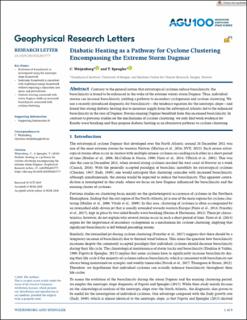| dc.contributor.author | Weijenborg, Christian | |
| dc.contributor.author | Spengler, Thomas | |
| dc.date.accessioned | 2021-02-10T18:04:07Z | |
| dc.date.available | 2021-02-10T18:04:07Z | |
| dc.date.created | 2020-09-30T11:00:23Z | |
| dc.date.issued | 2020 | |
| dc.Published | Geophysical Research Letters. 2020, 47(8) | en_US |
| dc.identifier.issn | 0094-8276 | |
| dc.identifier.uri | https://hdl.handle.net/11250/2727286 | |
| dc.description.abstract | Contrary to the general notion that extratropical cyclones reduce baroclinicity, the baroclinicity is found to be enhanced in the wake of the extreme winter storm Dagmar. Thus, individual storms can increase baroclinicity, yielding a pathway to secondary cyclogenesis and cyclone clustering. We use a recently introduced diagnostic for baroclinicity—the tendency equation for the isentropic slope—and found that strong diabatic heating due to moisture supply from the subtropical Atlantic led to the enhanced baroclinicity in the rear of Dagmar. Storms ensuing Dagmar benefited from this increased baroclinicity. In contrast to previous studies on the mechanisms of cyclone clustering, we only find weak evidence for Rossby wave breaking and thus propose diabatic heating as an alternative pathway to cyclone clustering. | en_US |
| dc.language.iso | eng | en_US |
| dc.publisher | AGU | en_US |
| dc.rights | Navngivelse 4.0 Internasjonal | * |
| dc.rights.uri | http://creativecommons.org/licenses/by/4.0/deed.no | * |
| dc.title | Diabatic Heating as a Pathway for Cyclone Clustering Encompassing the Extreme Storm Dagmar | en_US |
| dc.type | Journal article | en_US |
| dc.description.version | publishedVersion | en_US |
| dc.rights.holder | Copyright 2020. The Authors. | en_US |
| cristin.ispublished | true | |
| cristin.fulltext | original | |
| cristin.qualitycode | 2 | |
| dc.identifier.doi | 10.1029/2019GL085777 | |
| dc.identifier.cristin | 1835386 | |
| dc.source.journal | Geophysical Research Letters | en_US |
| dc.source.40 | 48 | en_US |
| dc.source.14 | 8 | en_US |
| dc.relation.project | Norges forskningsråd: 262220 | en_US |

